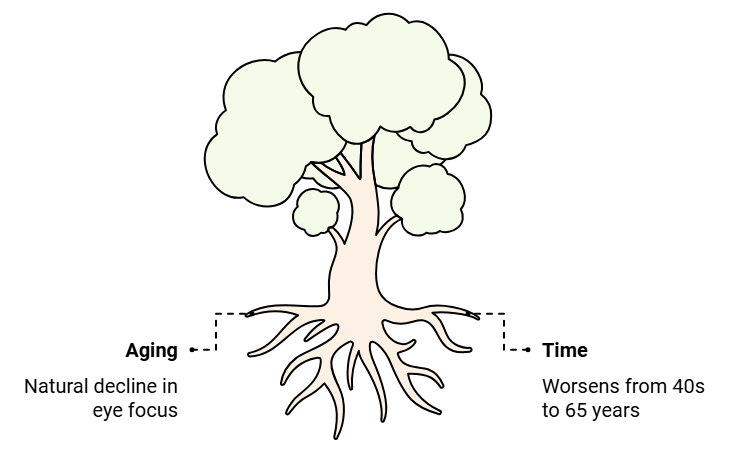Important Definitions and Equations: The Human Eye and the Colourful World | Science Class 10 PDF Download
Definitions
- Cornea: The clear front part of the eye that bends light as it comes in.
- Iris: The coloured section of the eye that controls how much light enters by adjusting the size of the pupil.
- Pupil: The tiny dark circle in the centre of the iris that lets light into the eye.
- Crystalline lens: Located behind the pupil, this clear structure changes shape to focus light on the retina. It becomes thinner for distant objects and thicker for close objects. The cornea initially bends the light, while the crystalline lens fine-tunes the focus.
- Focal length: The distance from the centre of a lens to its focal point.
- Retina: The inner layer of the eye filled with light-sensitive cells (rods and cones) that create images. This delicate membrane has many light-sensitive cells that, when exposed to light, send electrical signals to the brain through the optic nerves.
- Cones: These cells are sensitive to bright light and are crucial for detailed and colour vision.
- Rods: These cells are more sensitive to low light and assist with peripheral vision.
- Optic nerve: A group of nerve fibres that transmits visual information from the retina to the brain.
- Blind spot: The area at the optic nerve's junction with the retina where there are no sensory cells, resulting in no vision at that point.
- Ciliary Muscles: Muscles that alter the shape of the lens to focus on objects at various distances (accommodation).
- Power of accommodation: The shortest distance for clear vision in a young person with normal eyesight is about 25 cm.
- Dispersion: The process of separating white light into its various colours, creating a spectrum.
- Scattering of light: This occurs when light rays change direction after hitting particles in the atmosphere.
- Tyndall Effect: This effect happens when light is scattered by particles in a colloid, making the light's path visible.
Myopia or Short-Sightedness
Myopia, also known as near-sightedness, is an eye defect that makes it hard to see objects that are far away:Cause: Light rays bend incorrectly and focus in front of the retina, instead of on it. This can be due to the shape of the eye or an elongated eyeball.Correction: Myopia can be corrected with concave lenses in glasses or contact lenses.
Hypermetropia or Long-Sightedness
Hypermetropia, also known as far-sightedness or long-sightedness, is an eye defect that makes it difficult to see nearby objects clearly. It occurs when light rays from a nearby object are focused behind the retina instead of on it, making it difficult to form a distinct image. Causes: Eyeball grows too short from front to back, or when there are problems with the shape of your cornea.
Correction: Convex lenses provide additional focusing power to shift the image from beyond the retina to the retina.
Presbyopia or Old Sight
Presbyopia is the gradual loss of your eyes' ability to focus on nearby objects. It's a natural, often annoying part of aging. Presbyopia usually becomes noticeable in your early to mid-40s and continues to worsen until around age 65.

Atmospheric Refraction
Atmospheric refraction is the bending of light as it passes through the Earth's atmosphere. This happens because the atmosphere is made up of layers with different optical densities.
- Twinkling of stars: They are point source of light and atmospheric refraction causes bending of light. Apparent image is higher than actual image and causes twinkling effect.
- Planets do not twinkle, as they are not point source of light
- Early sunrise and late sunset: Sun can be seen two minutes before actual sunrise and two minutes after sunset due to atmospheric refraction.

Formulae
Lens Formula:
 where f is the focal length, v is the image distance, and u is the object distance.
where f is the focal length, v is the image distance, and u is the object distance.Magnification (m):
 (Negative sign indicates the inversion of the image formed by the lens)
(Negative sign indicates the inversion of the image formed by the lens)
Power of Accommodation
- Least Distance of Distinct Vision (D):
- The minimum distance at which the eye can see objects distinctly without strain.
Defects of Vision and Their Correction
(a) Myopia
- Lens Power for Myopia (concave lens):

(b) Hypermetropia
- Lens Power for Hypermetropia (convex lens):

(c) Presbyopia
- The loss of accommodation with age.
Refraction of Light Through a Prism
- Angle of Deviation (Δ):
- The angle through which a ray of light is deviated by a prism.
Dispersion of White Light by a Glass Prism
- Refractive Index (n):
 where A is the angle of the prism, and δ is the angle of minimum deviation.
where A is the angle of the prism, and δ is the angle of minimum deviation.
Atmospheric Refraction
- Apparent Shift in Position:
- The apparent position of celestial objects due to atmospheric refraction.
Scattering of Light
(a) Tyndall Effect
- The scattering of light by colloidal particles.
(b) Why is the Colour of the Clear Sky Blue?
- The scattering of shorter wavelengths (blue light) by air molecules in the atmosphere.
These formulas and concepts summarize the key elements of the chapter.
|
80 videos|569 docs|80 tests
|
FAQs on Important Definitions and Equations: The Human Eye and the Colourful World - Science Class 10
| 1. What are the main parts of the human eye and their functions? |  |
| 2. How does the human eye perceive colors? |  |
| 3. What is the role of the lens in the human eye? |  |
| 4. What is the significance of the blind spot in the human eye? |  |
| 5. How does the human eye adapt to different lighting conditions? |  |

















